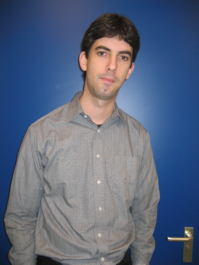Low-Drift Micro Flow Sensors
Promotion date: 12. June 2009
Promotor: Prof.dr. Miko Elwenspoek
Assistant promotor: Dr.ir. Remco Wiegerink
| Low-drift micro flow sensors were developed for accurate measurement of minute amounts of liquid flow in the nl/min range. A microchannel fabrication concept was developed, based on buried channel technology. The channel technology has found application in the fabrication of resonant flow sensors and low-drift micro flow sensors. Low-drift micro flow sensors were investigated, using two heaters and a thermopile in order to eliminate material drift. Influence of external temperature gradient where compensated for by sensor design. |
How did you proceed in conducting your research?
I started working in the cleanroom at already an early stage. The goal was to realise a micro thermal flow sensor using nanochannels for on-chip transport of fluid. Realising the first prototype turned out to be more difficult then expected. Several technical problems arose during fabrication and characterisation. The most prominent problem was the high pressure drop across fabricated nanochannels, which inadvertently occurs when trying to measure nl/min flow by thermal measurement methods.
After the initial setback I took sufficient time to study literature and to develop sensor models. It made me somewhat sceptical to the initial push towards the cleanroom, as most problems were clear from literature and basic modelling. After gaining more insight I devised ways to adapt the existing buried channel technology (BCT) for use in micro flow sensors applications, avoiding many problems.
With the so-called surface channel technology (SCT), freely-suspended microchannels are fabricated just below the wafer surface, while transducer structures can be integrated using standard IC-techniques. I demonstrated the versatility of the technology for thermal flow sensing, fluidic-resonance sensing and possible other micro-fluidic applications. The use of SCT for micro flow sensors has resulted in a patent and a colleague is successfully applying the technology in a micro-Coriolis resonance flow sensor, which shows commercial potential for use in HPLC applications.
My own research led me to the reduction of drift influences in micro thermal flow sensors. A measurement technique using thermocouples was investigated and external temperature disturbances where compensated for by smart sensor design. This has resulted in micro thermal flow sensors with higher resolution and accuracy for liquid flows in the nl/min range and possibly below.
What are your plans for the near future?
I want to finally prove that the realised low-drift micro flow sensors can measure near pl/min liquid flow, which would make the flow sensors useful in nanofluidic research applications. For that I hope to be facilitated with dedicated electronics and a good calibration setup in the foreseeable future.
Meanwhile, I will possibly start as post-doc for a year in collaboration with researchers at the University of Leiden. The research topic will be on electrospraying from nano-sized apertures for mass-spectrometry. Already during my promotion work, I started the fabrication and characterisation of prototype electrosprays, where nano-sized emitters are integrated with SCT microchannels for on-chip transport of fluid. This concept can possibly be investigated further in the coming year.
During my promotion work an important part of the research was directed toward applications. In this more academic research I hope to be able to investigate some fundamental aspects. It will be interesting for me to study literature and theory in more detail, in order to get an understanding of this completely different field of research. Hopefully this will allow me to answer fundamental questions, like the size distribution of droplets formed during the electrospraying process and the physical principles involved.
What is in your opinion important for the Mesa+ institute to stay successful in the near future?
First of all to maintain the open cleanroom facilities. During my project I performed a number of cleanroom runs and by doing so I learned a lot more about different cleanroom techniques and gained knowledge about passing a MEMS device through all stages of design and fabrication. That is a good and unique opportunity that cannot easily be obtained working for a company where operators run the machines. Having this knowledge and toolkit available allows the Mesa+ researcher to be creative and to possibly do some good research.
From this point of view Mesa+ is an important educator for young researchers. Our research group, for example, started with two design routes in the curriculum. One of these uses SCT as a kind of “construction kit”. Students can design a MEMS device on their own, using the SCT microchannels as “building blocks”. The devices are then fabricated in the cleanroom and success or failure of the device is up to the design made by the students. In both cases much can be learned.
Some students have shown to be very innovative with the technology given, for instance, a resonating MEMS micro-mirror has successfully been demonstrated. It would be great if this motivates even more students to do useful research on their own and to really get to know what is happening behind the yellow windows of the Mesa+ cleanroom.

